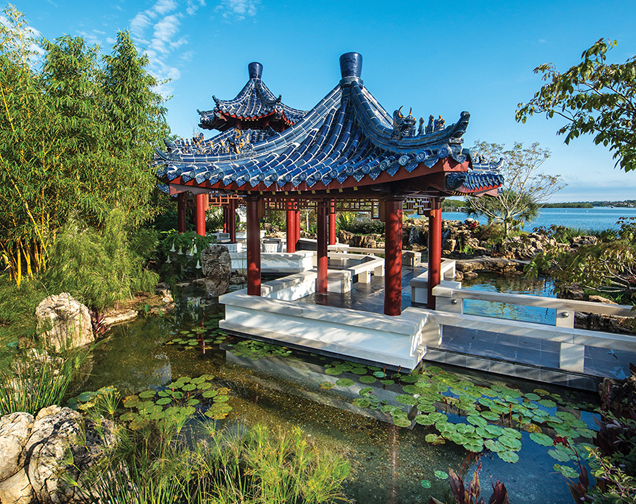
Chinese and Japanese water gardens are by far my favorite of all the “living” water feature types, both to visit and to design. They are also the most challenging to both design and build! This style has been enjoyed for thousands of years. Kings and members of the nobility commissioned and perfected them as early as the Shang Dynasty (1600-1046 B.C.).
Chinese and Japanese gardens are designed to stimulate one’s intellect and spirit, while encouraging one to wander in nature and experience an oasis of tranquility. When properly designed and constructed, the four key elements of rock, water, plants and architecture create an ever-changing (by the minute, hour, season) and rejuvenating environment.
In the spring of 2011, Synergy Builders, a general contractor, and Michael Gilkey Landscape Architecture — both from the Sarasota, Florida area — contacted me to assist with the final design and construction of a koi pond that was to surround a significant portion of an authentic Chinese pagoda.

This private pagoda garden is a unique environment on Casey Key, one of the barrier islands on Florida’s west coast. What sets this project apart from others is a number of elements: the Chinese pagoda, built from authentic, timeless material; a one-of-a-kind koi pond; a greenhouse in a conservatory style; and the fact that it is supremely energy-efficient and sustainable.
The main feature of this garden is the pagoda structure, which is actually three pagodas connected together with the center, main pagoda being the larger. All the roof tiles and ornamental details are authentic, handmade Chinese pieces, designed for this particular garden.
As the building of the pagodas progressed, the primary concerns of both the general contractor and landscape architect regarding the expertise of the Japanese water garden contractor were threefold. They wanted to find a contractor who was knowledgeable about the multiple complexities of the design, would be fully capable of providing all the resources necessary, and had the ability to execute the water and stone work to a high artistic and quality standard, correctly, the first time.
Elements of Water in the Garden
The water element of the garden is divided into two separate yet interconnected ponds. The main body is the koi pond, which is designed to be approximately 85 feet long and averages 20 feet in width with a maximum depth of approximately 4.5 feet. There are two very different waterfalls in the koi pond and a third, smaller and intimate waterfall hidden in the landscape, only to be enjoyed by those venturing out into and exploring the garden. The refugium pond, which is the smaller of the two (60 feet by 15 feet), is on the opposite side of the pagoda and connected via hidden balance pipes that run through the structure. This portion of the pond is to be used as an additional organic biological filter and aquatic garden.
On the far side of the koi pond, opposite from and facing the central area of the main pagoda, is the primary waterfall and sheer rock formation rising 5 feet above the koi pond, providing for a broad, multi-faceted waterfall. This waterfall combines tall and graceful falls as well as cascading falls.Within the waterfall structure, ledges and splash basins have been designed to allow for and control “conflict” within the moving water. This conflict causes minute air bubbles to be captured in the moving water, making the moving and falling water more easily seen.
The orientation of the cantilevered and stepped rocks within the structure, as well as the water depth of the splash basins, allows the pitch of the falling water to be controlled. The actual water flow, intensity and volume of the falls are controlled through a Lutron system, allowing the client to enjoy various levels of visual and audible effects.
Elements of the Garden
Stone is the hard skeletal structure of the world. The most prized stones for Chinese water gardens are Taihu stones, which are very hard, water-worn, strangely shaped, vertically standing stones, given honored placement in the garden. These rocks are prized for their four virtues: the holes that allow life force to flow freely, the rough texture, their slenderness, and being top-heavy. Taihu Stones set up as vertical abstract sculptures have also been called “scholar” rocks.
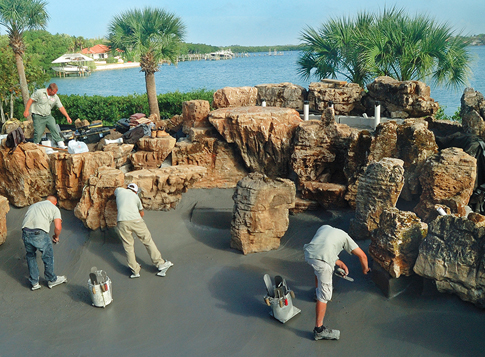
Water is the lifeblood of the world. In Chinese gardens the solidity of stone (yang) is balanced with the softness of water (yin). When paired together (yin and yang) there is balance, which creates rejuvenating energy called “qi” energy.
Besides what is obvious, such as color, fragrance and blooms, there are important cultural symbols associated with plants in Japanese water gardens. Plants represent vitality. Lotus in a pond or lake present the essence of purity, growing out of mud and being cleansed as they emerge through the surface of the water. Bamboo is an evergreen plant that symbolizes strength, courage, flexibility and integrity.
A common feature of Chinese garden architecture is the waterside pavilion — a derivation of an ancient wooden house supported on stilts. It later became the fashion to build waterside pavilions upon the lake or pond of a garden so that half the structure was built on land while the other half was raised on stilts above a body of water, so as to allow viewing of the garden from all sides of the building.
In Search of Stone
Early into the project, the selection of the specific stone to be used was critical. The stone had to be located within the USA, and had to closely resemble the four virtues of the Taihu Stone of Japan. To ensure only the best stones were sourced, nearly 200 tons of extremely weathered and aged stone had to be located, hand-selected, carefully collected, loaded and shipped to the project. Once the stones arrived on-site, the individual stones were sorted and matched with other stones, meticulously fitted together to create the dramatic rock-scapes and weathered bridges typical of a Chinese garden.
Character boulders (above, left) are boulders that have unique shapes and weathering patterns that create strong visual interest. Scholar rocks (above, right) are typically vertical, top-heavy, weathered rocks, strategically placed in the garden.
One of my major highlights of the stone search effort was the discovery of a wonderful bridge stone. This prize find was well-hidden among the rocks, trees, brush and brambles. It was only on my third encounter with it that I truly began to see and recognize all the wondrous qualities and potential of this one stone. Now permanently at home in the water garden, this amazing stone measures approximately 12 feet in length, varies in width from 3 to 4 feet, has a slight arch as well as a twist to its form, is weathered on all sides, and has a beautiful coating of multicolored lichen thriving on its surface. Altogether, these traits create a beautifully formed, natural bridge walkway — an enhancement to any Japanese water garden.
Design Challenges
Some of the key challenges to overcome were based on how to extend the Chinese authenticity into the gardens surrounding the pagoda. The most obvious elements included calm and moving water, stone bridges, scholar rocks and landscape stone, as well as aquatic plantings. Less obvious is the fact that in Asian gardens, a visitor is not privy to the entire garden from any one vantage point. Mystery and perceived destinations are built into the garden to entice one to walk and explore. Where does that walk go? What’s over the bridge? Where are the waterfall sounds coming from?
As the goals and design of this project progressed, so did the concerns regarding the existing local climatic and environmental elements, which could disrupt our efforts. Unfortunately, they were plentiful! An example of one primary obstacle: Florida is home to a large population of predatory birds, to which koi in a pond are equivalent to a sushi bar at happy hour! To counter this free smorgasbord, the pond shape and landscaping were configured to disallow easy flight access into the area, and there are no easy perches along the entire perimeter of the pond.
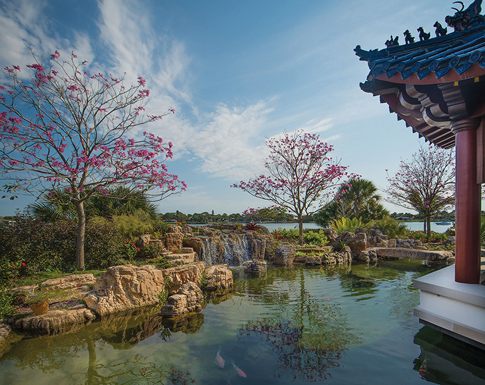
A second obstacle is climate — namely, Florida’s very warm temperatures and intense sunlight, both factors being key ingredients to growing algae. To counter the effects of the heat and the sun in aiding algae growth, nature and technology were combined. In a remote equipment room, multiple pumps, biomechanical filters, ozone and UV sterilization were set up. This combination effectively, automatically and continuously works to remove organic nutrients from the water that algae would use to grow and reproduce.
An expert combination of design and construction — involving the artistic skills, education and years of experience of Synergy Builders, Michael Gilkey Landscape Architecture, David B. Duensing Aquatic Construction Services and David B. Duensing & Associates Aquatic Design — evolved into the tranquility, mystery, and beauty of this authentic Japanese water garden, surprisingly situated on the Intercoastal Waterway in Casey Key, Florida. The natural stone formations; clear, crisp water for colorful koi visibility; musical water tones; multihued aquatic and terrestrial plantings; water reflections; low-maintenance technology; and sustainability all make the end result a magical destination, only to be revealed and enjoyed with the visit of many seasons.
David B. Duensing, a long-time industry expert and educator, created Aquatic Construction Services, LLC in 2006 specializing in combining natural stone, living water and his clients’ dreams to build unique and exceptional aquatic features throughout the Americas, the Caribbean and abroad.

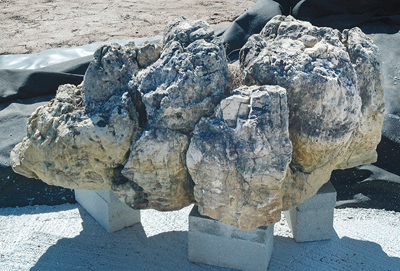
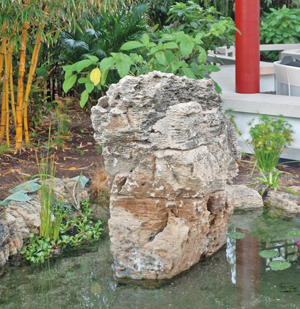


Absolutely stunning watergarden!
Chinese and Japanese gardens are designed to stimulate one’s intellect andspirit, while encouraging one to wander in nature and experience an oasis of tranquility.Pondpro2000 is helping to keep pond live and fresh.